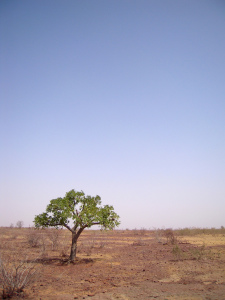Thirsty land: Are humans to blame for the failure of the West African Monsoon?
Who is to blame for that storm? For this flood? For that drought or heatwave? Decades ago, such questions would seem meaningless: no human agent was thought capable of inducing changes in the weather. Earth’s climate was immutably natural, of a majesty and complexity that rendered it far beyond the power of man’s feeble finger to adjust. But now we know better: we can, through climate change, at least change the likelihood of extreme weather, causing others’ suffering that can in some cases be directly attributed to our actions.
If we could compute the total enjoyment lost to early death, ill health, malnourishment or displacement because of climate change, we could in theory divide it by humanity’s total greenhouse gas emissions and predict the damage done by each gram of carbon. Such a figure really would be a turn-off to anyone tempted to turn up the thermostat or switch on the light. But of course, things aren’t that simple. Carbon concentrations in the atmosphere can naturally vary, and sometimes critical points have to be crossed before human emissions will make any noticeable change to the average conditions in any given region, which constitute its climate. Moreover, shorter-term local conditions – the weather – are always very variable. Even where a region’s climate is changing according to a long-term trend, proving that any extreme weather events would not have happened naturally is far from straightforward.
Yet there are some cases in which a human link to bad weather is more easily visible, even if we don’t understand its full extent. Perhaps the most important example is that of the West African Monsoon. Some fifty million people, living in the Sahel region of Africa, are dependent on the monsoon rains of the boreal summer to water their crops. At that time of year, moist air from the Gulf of Guinea rises inland, and where it meets the hot, dry Harmattan air from the Sahara deep convection sets in to produce heavy rainclouds and storms. But the process is strongly dependent on the land and sea temperature and atmospheric composition, and the rains do not always come. Because the region’s water supply depends so strongly on such a short window of rain, a disruption to the monsoon rapidly brings about drought and famine.
We know that this has occurred many times over recent centuries, and precipitation has cycled between high and low states. However, since the late 1960s the monsoon has been especially weak, resulting in a thirty-percent reduction in rainfall compared to average. Many theories have been put forward to explain such an exceptionally long drought, and most of them put humans squarely to blame. The first of these pins the blame on local colonial and post-colonial planners. In 1977 Charney[i] proposed that an increase in amount of solar radiation absorbed by the ground – caused in this case by ill-advised deforestation and overgrazing – could reduce the ability of clouds to form by convection, which requires the ground to be warm. More recently, the blame has been shifted to the industrialised world. Warming to the Gulf of Guinea because of greenhouse-gas-induced climate change could weaken the monsoon and move the rains southwards towards the coast. Or it could be that sulphate aerosol pollution, again from the industrialised world, produces the same effect by changing the properties of the clouds.
It’s undoubtable that there are also natural factors: human activity can’t explain the relatively wet conditions in the Sahel immediately prior to the drought, and since it began its severity has varied considerably. But here, as elsewhere, it’s clear that humans are aggravating extreme weather and turning our own, hospitable environment against ourselves. The frequency of harmful weather events is increasing with climate change. That we can’t quite attribute the blame for any single one of them doesn’t leave us guiltless, nor detract from the need to urgently change the way we treat our planet, for our own sakes.
[i] Charney, J; Quirk, W; Chow, S and Kornfield, J : A Comparative Study of the Effects of Albedo Change on Drought in Semi-Arid Regions (Journal of the Atmospheric Sciences 34:1366-1385, September 1977)
![Extreme Weather: Who’s to Blame? Thirsty land: Are humans to blame for the failure of the West African Monsoon? Who is to blame for that storm? For this flood? For […]](/wp-content/uploads/2014/11/Sahel-640x361.jpg)
